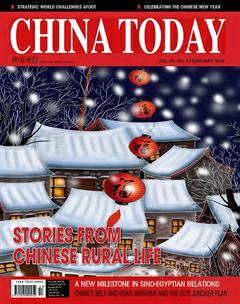The Formation of Confucian-Legalist China
The Formation of Confucian-Legalist China

The Confucian-Legalist State: A New Theory of Chinese History Author: Dingxin Zhao Price: US $85 Hardcover, 480 pages Published by Oxford University Press
P ROFESSOR of sociology Dingxin Zhao of the University of Chicago’s book The Confucian-Legalist State: A New Theory of Chinese History, published in November 2015 by Oxford University Press, has sparked much discussion among historians and sociologists.
Professor Ho-fung Huang of Johns Hopkins University said of the book, “Zhao’s work combines vast historical evidence, cutting-edge social theories, and rigorous analytical strategy to present a compelling case for why China’s pattern of state formation diverged from Europe’s more than two millennia ago, creating a Confucian-Legalist centralized bureaucratic state that lasted into modern times. It is historical social science at its best.”
Dingxin Zhao first uncovers in his 13-chapter book the factors that explain how and why China developed into a bureaucratic empire under the Qin Dynasty in 221 BC. It then examines the political system that drew on China’s philosophical traditions of Confucianism and Legalism which crystallized during the Western Han Dynasty (202 BC-AD 8). Despite great changes in China’s demography, religion, technology, and socioeconomic structures, this Confucian-Legalist political system survived for more than two millennia. Yet, it was precisely because of the system’s resilience that China, for better or worse, did not develop industrial capitalism as Western Europe did, notwithstanding China’s economic prosperity and technological sophistication that began with the Northern Song Dynasty (960-1127).
An outstanding sociologist, Zhao’s research encompasses historical sociology, social movements, social changes, economic development, and democratic transformation. The Confucian-Legalist State: A New Theory of Chinese History highlights war as a dominant force behind China’s social changes. From Zhao’s perspective, legalism is the most effective war mobilization theory. Legalist reform, therefore, is representative of competitive isomorphic pressure rather than historical progress. Value rationality governed the actions of aristocrats in the early Spring and Autumn Period (approx. 771-476 BC). For instance, battles among different states strictly followed the Zhou Dynasty (1066-256 BC) system of rites and music. However, if one state scrupulously toed the line while its opponent pursued paramountcy of own interests, the former, thought-fettered party would invariably lose the battle. Rivals consequently changed their approach to winning by abandoning the conventions of restraint. Instrumental rationality thus superseded value rationality and developed into a decisive factor of social development, territorial expansion, the struggle for hegemony, and even dynastic changes. From this point of view, the Qin Dynasty’s achievement of a unified, bureaucratic empire was dependent on the successful reform of legalism.
Although the ruling ideology of Qin rulers helped build a great empire, it also brought about its instant destruction. Successive rulers of the Han Dynasty (202 BC- AD 220) adopted the rehabilitation policy, and the seventh Emperor Wudi of the Western Han Dynasty made Confucianism the official ideology. Confucianism eventually realized canonization during the Eastern Han Dynasty. As the ruling ideology, Confucianism and legalism gradually developed into typical features of ancient Chinese political institutions that lasted till the end of the last dynasty Qing (1644-1911).
Zhao points out in this context that during the prolonged course of history, the official Confucian ideology encountered at least two challenges from abroad, both of which stemmed from the Silk Road and Maritime Silk Route.
The Silk Road formed during the Han Dynasty after envoy Zhang Qian’s travel westward to Central Asian countries during the reign of Emperor Wudi (202-87 BC). Zhang Qian transported large quantities of goods along the Silk Road, and introduced Buddhism to China via trade. Buddhism is a fundamental philosophy which regards life as suffering and the mortal world as one of disillusionment. The divergences between traditional Confucianism and Buddhism had great impact on the political system. This ideological battle continued through to the mid-Tang Dynasty (618-907) and Northern Song, when Neo-Confucianism came to the fore and Buddhism became localized. A stable combination was eventually achieved, whereby Confucianism was the ruling feudal ideology that encouraged people to participate in, govern and consolidate secular society; and Buddhism assuaged the sufferings of the common people, alleviated social contradictions and thus maintained feudal order.
The second period of conflict occurred during the Tang Dynasty, due to the Maritime and Land Silk Roads. It was at this time that, along with exchanges of goods between China and the Western world, Islamism entered China. This new religion faced the challenges of burgeoning Neo-Confucianism and also the empire’s two institutional bases: the imperial examination system and patriarchal system based on village communities. Muslims were hence forced to clear two immense hurdles in order to survive and develop in China: one was participation in the imperial examination to achieve social status, the other was to make the religion more acceptable to the indigenous population by combining it with the predominant Confucianism. This invisible pressure accelerated the localization of Islamism and transformed Muslims into an ethnic group.
Another important viewpoint the author expresses is that the discrete relations between nation and religion rendered ancient China, as compared to other main civilizations of the world, a land of religious freedom. This is not to say that the Chinese civilization was superior to others, but that the Confucian-dominated nation indeed offered social elites a pathway to higher official positions and wealth by competing in the imperial examinations. This is why Confucianism constantly met challenges, but nevertheless continued to evolve over the past two millennia.

